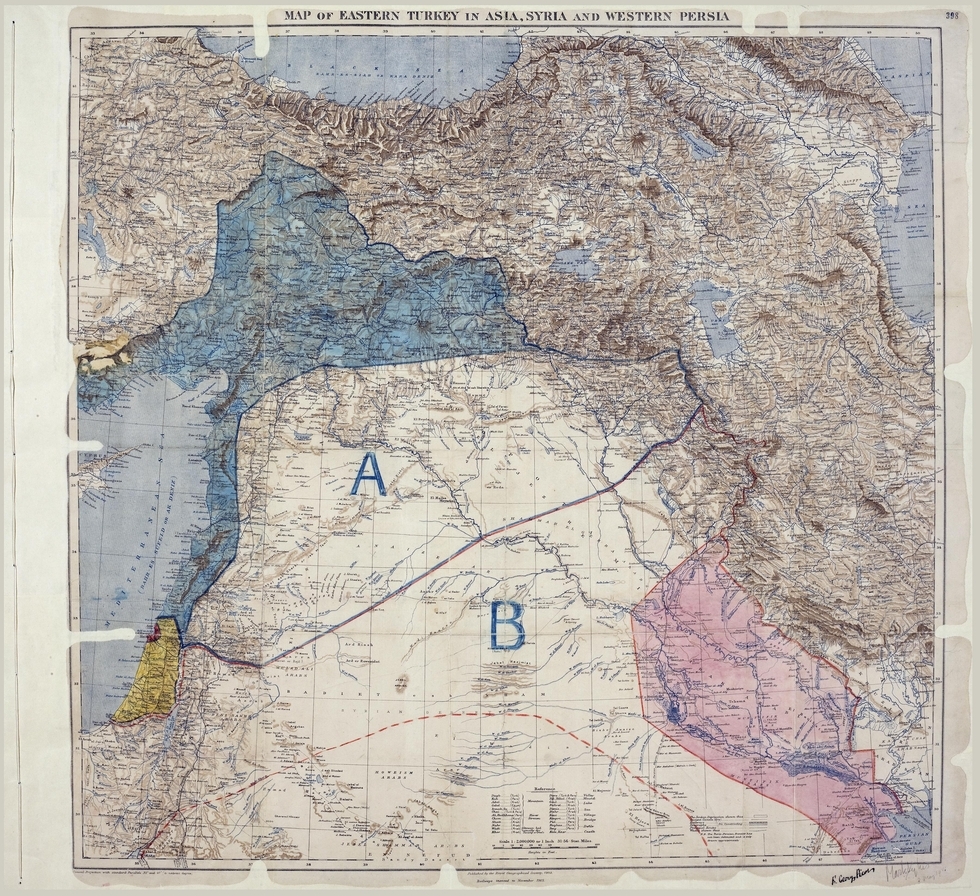Sykes-Picot: One hundred years on

The commemoration of the centenary of the signing of the Sykes-Picot Agreement turned out to be bigger than expected. Arab and English language documentaries, important chapters or books, conferences and workshops, and scores of articles and commentaries were published during the weeks preceding 16 May.
Within the Arab space, the anniversary took on a more sombre note this time. Harsh self-criticism, which usually accompanies the commemoration of hateful historic events, has disappeared. Some of what was published about discovering the relationship between the legacy of the regional regime, which was born out of the First World War, and what the Arab Islamic East is witnessing today has contained, in some parts of it, grievous errors.
Some of it did indeed provide solid evidence about the necessity of revisiting what precipitated in the conscience of the region’s peoples during this extraordinarily important era. At this juncture, there are a number of issues that are worth paying attention to, whether for the experts or for the Arabs as a whole.
First of all, Sykes-Picot was an agreement over the division of the Ottoman properties, including Arab majority provinces, as there were no Arab states at the time. Furthermore, Sykes-Picot was not the only agreement on dividing the Ottoman countries among the Allied countries during the First World War. But yes, it was the most prominent one.
In March 1915, prior to Sykes-Picot, Britain, France and Russia agreed to what was known as the Constantinople Agreement in a meeting held in the Russian capital Petrograd. It was agreed to give Russia the Ottoman Straits and the territories adjacent to them, including Istanbul itself. It can be said that Russian insistence on obtaining the approval of the two other allies in the war was the main reason why London began studying what the British interests in the East were, and the reason behind Paris’s insistent demands that an agreement be concluded between Britain and France to determine the interests of both countries.
Second, discussions between Mark Sykes of Britain and the Frenchman Francois George-Picot, did, indeed, end up with an agreement on 3 January 1916. But the official signing was delayed until 16 May 1916, in anticipation of approval from the Ministry of War and the British departments concerned with the Middle East.
As is already known, the agreement included the division of what is today recognised as the Arab East and the south of Turkey into regions under direct British or French administration and into areas of influence for each of the two states; whereas Jerusalem and its neighbouring territories become internationalised. Less than a year later, in the middle of 1917, in a meeting at the resort of Saint-Jean-de-Maurienne, France and Britain agreed to grant Italy the southwest of Anatolia, or the region that is known today as Antalya.
Hence, the three agreements provided an outline for the Ottoman Sultanate that confines Arab independence to the Arabian Peninsula, and Turkish independence to the heart of Anatolia. All the other Ottoman territories were divided between Russia, France, Britain and Italy.
Third, the Zionist movement had no direct or indirect role in Sykes-Picot or in the overall agreements that divided the properties of the Sultanate. This was not just because the Zionist movement was nothing but a marginal force in the international arena, but also because there was no direct link between the Zionists and the negotiation parties in all three agreements.
Dividing the east was a purely imperialist project born out of the contradiction of interests among the four concord states, and their attempt to resolve this contradiction through negotiations. The arrival of the Zionists on the scene occurred after negotiations between Sykes and Picot were concluded, and after the agreement was reached. The entry of the Zionists happened because of British willingness and due to a purely British endeavour. It was not a result of the skills or the influence of any of the Zionist leaders including Chaim Weizmann, the person in charge of the Zionist Organisation - which was still small at the time - in Britain.
The response from most of the British government departments to the draft of the Sykes-Picot agreement was negative. A number of British officials expressed their conviction that the agreement gave France more than it deserved.
One of the most prominent reactions was the set of observations made by Captain Reginald Hull on 12 January 1916. He pointed out that the conception put forward by the agreement for the Palestine area - which had not yet been defined geographically in any clear terms - did not take into consideration the ambitions of the Jews and the Zionist movement in the region.
That was the first time in which Mark Sykes - who was Catholic - became conscious of the existence of a Zionist movement among the Jews, and of the interest that movement was showing in Palestine. And because a feeling was born in London, even before signing the Sykes-Picot agreement, about the necessity of searching for a means of relinquishing the British obligations in the agreement, Sykes asked his friend in the Foreign Office, Hugh O’Brian, who knew Weizmann, to arrange a meeting between them. This was the beginning of Sykes’ acquaintance with the Zionist movement and its ambitions.
During subsequent months, and with the approval of Foreign Secretary Grey and Prime Minister Asquith - both of whom were not known to have Zionist sympathies - Sykes continued to conduct what amounted to negotiations with the leaders of the Zionist movement and introduced them to the French and the Italians, and even opened the gates of the Vatican for them. The objective of Sykes and the British government had become securing a place for the Zionist movement around the table that discussed the future of the East. This was a means of breaking loose from the agreement with the French, and opening the doors for renegotiations over the borders and interests of the two states.
Fourth, the main role that led to the annulment of the three agreements concluded during the war, and to forcing all parties to sit and renegotiate once more was played not by the Zionist movement, but rather by the war's events and developments that changed realities on the ground. Following the seizure of the Concord States of Istanbul and large swathes of territory in the south and southwestern Anatolia, and the Greek seizure of Izmir and its neighbouring territories, a major war of independence erupted in 1919. This was an Ottoman and not a Turkish war of independence as stated by the official Turkish history of the republic, because Turkey had not yet been born.
In Britain, which shouldered the burden of the war in the Middle East, the new prime minister, Lloyd George – who took office in the beginning of 1917 - insisted that Sykes-Picot be implemented as it was. Then Russia saw the eruption of the Communist revolution in October 1917 that put an end to the rule of the Tsars and relinquishment by the Bolsheviks of the agreements with Britain and France, and even the publication of the texts of the agreements.
Fifth, the eventual picture of the regional regime in the Middle East, the post World War I regime, was the product of new agreements. The Arab states, as we know of them today, were born out of the San Remo agreement in April 1920. As for present-day Turkey, it was initially forced to swallow the Treaty of Sèvres in August 1920, which included the application of the San Remo results on what remained of the Ottoman State.
However, the government of the Great National Council in Ankara, which was leading the war of independence, rejected the agreement. Following the victory of the independence war forces in Izmir in the summer of 1922, the Concord States were forced to negotiate with Ankara leading to the Lausanne Agreement in July 1923. Yet the agreement did not resolve the issues of Mosul and Iskenderun, each of which had been occupied by British and French forces since the signing of the Armistice of Mudros in October 1918.
Since the war of independence was waged on the basis of a national covenant that stressed the independence of all the Ottoman lands, as they were on the eve of the signing of the Armistice of Mudros, the issue of Mosul was resolved in the mid-1920s by means of a referendum, according to which was kept as part of the new Iraq. The issue of Iskenderun was resolved by forcing the French to withdraw in 1938.
As for Turkey’s new borders with Bolshevik Russia, these were first drawn in the Treaty of Brest-Litovsk, which was signed with the government of Istanbul in March 1918 and then in the Moscow Treaty with the government of Ankara in April 1920. According to both agreements, Turkey regained Agri, Qaris and Ardakhan, which had been occupied by Tsarist Russia during the Russian-Ottoman war between 1877 and 1878.
So, what is to be concluded from all of this? The will of the big powers was not absolute, and it is not so today. It was not only Russia that sank in civil war for many years in the aftermath of the Bolshevik revolution, France and Britain came out of the war in full exhaustion too. They were simply unable to wage new wars.
If only the Arabs had had a decisive leadership similar to the Ottoman war of independence leadership, they might have been able to gain their independence and unity right from the start. However, the Hashemite leadership of the Arab movement was not at the level of Arab ambitions and aspirations.
The other problem is to do with awareness. The history of the peoples of the new Middle East, even during the most critical moments of history – such as during the First World War - was subjected to extensive falsification by states and nationalist movements. It is perhaps time to re-write that history and rebuild awareness on the basis of what actually did take place.
- Basheer Nafi is a senior research fellow at Al Jazeera Centre for Studies.
The views expressed in this article belong to the author and do not necessarily reflect the editorial policy of Middle East Eye.
Photo: A map of the Sykes-Picot agreement, which was enclosed in a letter sent on 8 May 1916, by Paul Cambon, the then French Ambassador to Britain, to Sir Edward Grey, the then British Foreign Secretary (AFP/THE NATIONAL ARCHIVES UK).
New MEE newsletter: Jerusalem Dispatch
Sign up to get the latest insights and analysis on Israel-Palestine, alongside Turkey Unpacked and other MEE newsletters
Middle East Eye delivers independent and unrivalled coverage and analysis of the Middle East, North Africa and beyond. To learn more about republishing this content and the associated fees, please fill out this form. More about MEE can be found here.





